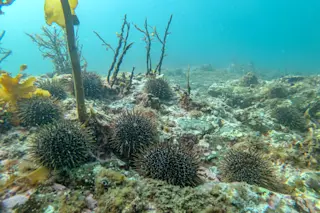In the future, nuclear clean-up workers may be getting help from some surprising sources. None of these three methods are in widespread use right now, but they show promise: 1) Algae
Scientists have discovered that a type of algae can precipitate strontium into crystals. This could lead to better nuclear clean-up techniques, potentially sequestering radioactive strontium-90 from tainted water into crystalline form, which is easier to contain.
The algae, called C. moniliferum, collects strontium in sulfate-rich vacuoles, and because strontium and barium have low solubility in sulfate solutions, they precipitate out of solution as crystals.
What's the Context: The danger of strontium-90 is that it is chemically similar to calcium, and so can be taken up into milk, bones, and other tissues. Nuclear waste and spills can contain significant amounts of strontium; C. moniliferum is especially helpful because it can precipitate strontium but leave calcium alone (calcium is different enough ...













